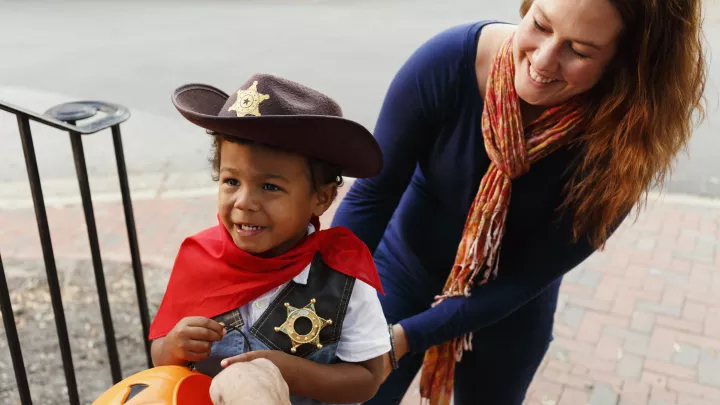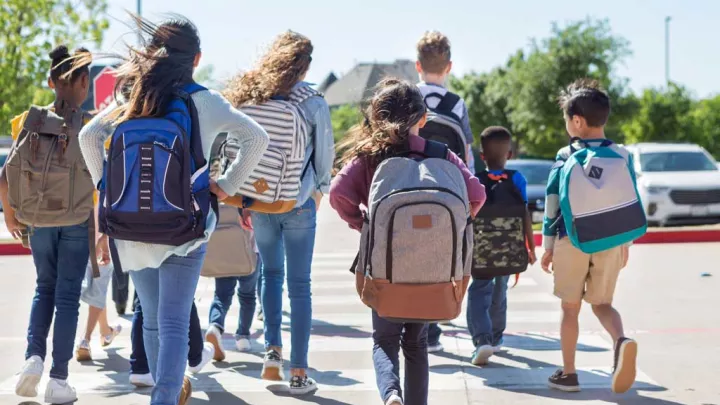
Kids and Bikes: Smart Moves for a Safe Ride
Riding a bike is a magical part of childhood and a fun activity for the whole family. Still, a bicycle is a vehicle—and it comes with risks.
“Kids will fall off bikes, but those injuries are usually minor. The biggest danger is a collision with a car,” notes Helen Arbogast, DrPH, MPH, CPSTI, Manager of Injury Prevention at Children’s Hospital Los Angeles.
So what can you do to ensure a safe bike ride for your child—and still keep it fun? Arbogast shares eight important tips.
1. Wear a helmet—always!
A bike helmet is the most effective way to prevent a head injury in the event of a bicycle crash. Riders of all ages should wear a helmet every time they ride, but for kids, it’s also the law.
In California, anyone under 18 must wear a bike helmet while on a bicycle, skateboard, scooter or roller-skates. (Note: It is illegal for any child under 18 to ride an electric scooter.)
Tip: Make sure your child’s helmet fits! A common mistake is for the helmet to sit too high on the head. There should be room for only one or two finger widths between the eyebrows and the helmet. Here are more tips on choosing the right helmet.
2. Keep kids under 10 on the sidewalk
Children under 10 typically cannot judge the speed and distance of cars. That means they should not ride bikes in the street unsupervised.
Young children should instead ride on the sidewalk—although they still need to watch for cars going in and out of driveways. Riding on park bike paths or beach boardwalks is another safe option.
“A child’s maturity level, not just age, has a lot to do with how much freedom you give them on a bike,” Arbogast explains. “Turning 10 is not a magic number to let them ride in the street.”
3. Know the rules of the road
If you can, ride your bike with your kids before letting them ride in the street alone. Teach children the rules of the road, including:
- Ride on the right side of the street—with traffic, NOT facing traffic.
- Learn and use hand signals.
- Stop at all stop signs and traffic lights.
- Make sure to look left, right and left again before proceeding to cross the street.
4. Learn the ABCS
Before heading out for a ride, teach your child to check the ABCS:
Air. Make sure tires are properly inflated.
Brakes. Be sure they’re working.
Chains. The chain should be attached and properly greased.
Spin. Tires should spin smoothly.
5. Look around
Always make eye contact with drivers. Just because you see the car does not mean the driver sees you.
When riding in the street, your child also must watch for parked cars (a door may suddenly open), cars going in and out of driveways, pedestrians and road hazards like potholes.
6. Dress to be safe—and seen
Make sure your child can be easily seen by drivers:
- Wear light and bright clothing.
- Use reflective stickers on shoes.
- Use a front headlight or flashing lights on the bike. The bike should also have rear reflectors.
In addition, don’t wear long or loose clothing that could get caught in a bike chain. Shoelaces should be tied and tucked in. Don’t wear flip-flops.
7. Choose a bike that fits
“Children grow, and sometimes bikes have to be adjusted for them,” Arbogast says. “Also, if a bike is too big, it disables the child’s ability to control the bike and to stop safely without falling.”
How do you know if a bike is the right size? Here are a few things to look for:
- When your child is seated on the bike, his or her feet should be able to touch the ground.
- Your child’s knee should bend slightly when his or her leg is fully extended when pedaling.
Handlebars should be level with the seat.
8. Don’t text and ride
Distracted riding is just as dangerous as distracted driving—if not more so. In a collision, a bicyclist is much more vulnerable to injury than someone in a car.
Set firm rules for your child:
- No phone use while riding. If you must use the phone, wait until you can pull over to a safe area and stop.
- No riding with headphones. Your child needs to listen for other cars, horns, people, etc.
- Eyes on the road at all times. Do not mount a phone to the handlebars!
“The distraction from devices is a huge safety issue,” Arbogast says. “Parents absolutely must have that conversation with their child. When those wheels are spinning, that phone can’t be in use.”


